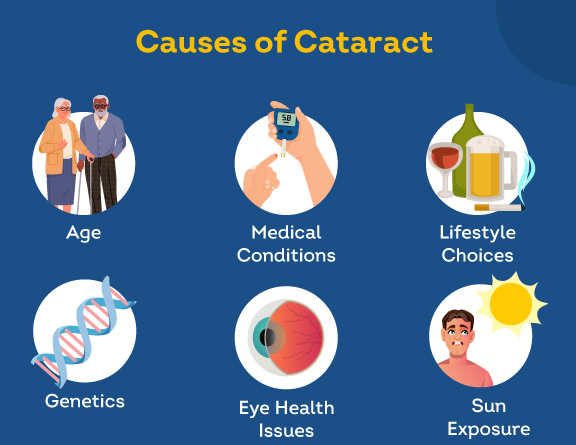
Select City
The development of nuclear cataracts, a condition that clouds the center of your eye's lens, is a natural part of aging that can impair your vision significantly. Thankfully, with advancements in medical technology, nuclear cataract surgery treatment has become a safe and effective solution to restore clear vision. The surgery involves the removal of the cloudy lens and its replacement with an artificial intraocular lens (IOL). If you are facing vision problems due to nuclear cataracts, don't compromise on your quality of life. Reach out to Pristyn Care today and book an appointment with our expert ophthalmologists for top-notch treatment.
The development of nuclear cataracts, a condition that clouds the center of your ... Read More




Free Consultation

Free Cab Facility

No-Cost EMI

Support in Insurance Claim

1-day Hospitalization

USFDA-Approved Procedure
Nuclear cataract surgery is a medical procedure designed specifically to treat nuclear cataracts. These types of cataracts primarily affect the nucleus, which is the central part of your eye’s lens, causing it to become cloudy or opaque. As this condition often develops with age, it can lead to substantial visual impairment if not treated timely.
Nuclear cataract surgery is typically an outpatient procedure, which means you won’t have to stay overnight in the hospital. During the surgery, the doctor will remove the clouded lens from your eye and replace it with an artificial IOL, effectively restoring your clear vision. The operation usually takes less than 20 minutes and has a high success rate, making it a popular choice for patients suffering from nuclear cataracts.

Fill details to get actual cost
When it comes to nuclear cataract surgery, there are different techniques that your doctor might consider based on your specific condition and overall eye health:
Your doctor will choose the best surgical method based on multiple factors including the density of your cataract, your overall eye health, and their own expertise.
Before proceeding with nuclear cataract surgery, it is crucial to confirm the presence of a nuclear cataract. Your ophthalmologist will carry out several tests to diagnose the condition which include:


The procedure for nuclear cataract surgery is well-established and can significantly improve vision and quality of life for those affected by this condition. The process entails:
Diet & Lifestyle Consultation
Post-Surgery Follow-Up
Free Cab Facility

24*7 Patient Support
Deciding to proceed with nuclear cataract surgery is typically based on an individual’s symptoms, the level of visual impairment, and the impact of the cataract on their daily life.
The following factors often determine a person’s suitability for this surgery:
Nuclear cataract surgery is a reliable procedure that aims to restore normal vision in individuals suffering from nuclear cataracts. Here are the key benefits of opting for this surgical treatment:
Preparing for nuclear cataract surgery involves several crucial steps to ensure the best possible outcome. Here’s how you can get ready for your procedure:
Follow Pre-Surgery Instructions: Patients are usually advised to avoid certain medications, refrain from eating or drinking for a specific period before the surgery, and use prescribed eye drops to prepare their eyes for the procedure.
Recovery after nuclear cataract surgery is generally a smooth process, but following your doctor’s post-operative instructions is key for optimal healing and vision improvement. Here are some tips for a successful recovery:
Although nuclear cataract surgery is generally safe and effective, like any surgical procedure it carries some potential risks. Here are some complications that may occur:
Remember, nuclear cataract surgery is a highly effective procedure that can greatly improve your vision and quality of life. Proper preparation and adherence to post-operative care can help minimise risks and enhance recovery.
Nuclear cataract surgery is a common eye procedure undergone by many in India. But how much does it cost? The price of nuclear cataract surgery treatment fluctuates depending on the following factors:
The average cost for nuclear cataract surgery can range from affordable to more expensive, depending on these factors. It’s always advisable to consult with a doctor or healthcare facility for exact costs.
The good news is that many health insurance policies in India do cover the cost of nuclear cataract surgery. However, the extent of coverage varies from policy to policy.
For instance, some insurance plans offer coverage up to certain limits based on the sum insured. Other plans may cover the cost only after a waiting period, generally around 2 years.
But keep in mind, not all insurance providers offer coverage for this type of surgery. Some policies may put a cap on the amount that can be claimed for nuclear cataract surgery. If your surgical expenses exceed the limit, you will need to bear the additional costs yourself.
Certain pre-existing conditions or medical circumstances may not be covered, or might require longer waiting periods before coverage is applicable. It’s essential to review the terms and conditions of your health insurance plan thoroughly to understand what is covered and what is not.
Lastly, insurance providers may use terms like “nuclear drop in cataract surgery” to describe specific surgical instances. Always read the fine print and understand all terms and conditions before purchasing a health insurance policy.
Nuclear cataract surgery and standard cataract surgery are quite similar in terms of their end goals, which are to remove the clouded lens (cataract) from the patient’s eye and replace it with a clear artificial lens. However, nuclear cataract surgery specifically targets nuclear cataracts, a type of cataract that forms deep in the central zone (nucleus) of the lens.
In the context of nuclear cataract surgery, nuclear drop refers to an unwanted situation where the cataract or parts of it fall into the vitreous humour, the clear jelly-like substance filling the back part of the eye, during operation. This complication may require additional procedures for complete removal.
Nuclear sclerosis is a type of cataract that causes the gradual hardening and yellowing of the lens in your eye. As this condition progresses, it can lead to blurred vision, difficulty seeing at night, and other vision problems that may necessitate nuclear sclerosis cataract surgery.
Not typically. Like all types of cataract surgery, nuclear cataract surgery is usually completed in less than an hour in most cases. The exact duration can vary based on individual circumstances.
Most patients report little to no discomfort during nuclear cataract surgery as it is usually performed under local anaesthesia. Mild discomfort post-surgery is normal but is generally well-managed with over-the-counter painkillers.
Your vision may start to improve within a few days of the surgery, but everyone’s experience is different. It may take several weeks for your eyes to settle and for you to experience the full benefits of the surgery.
Nuclear cataract surgery is highly effective in restoring clear vision. Most people notice significant improvement in their sight after recovery.
During nuclear cataract surgery, your clouded lens will be replaced with an artificial IOL. There are several types of IOLs available, including monofocal, multifocal, and accommodative lenses. Your doctor will discuss these options with you and help decide the best type for your needs.
In some cases, yes. Certain types of IOLs used in nuclear cataract surgery can correct other vision issues such as nearsightedness, farsightedness, and astigmatism.
Yes. Nuclear cataract surgery is usually performed on an outpatient basis, meaning patients can go home the same day once they have recovered from anaesthesia.